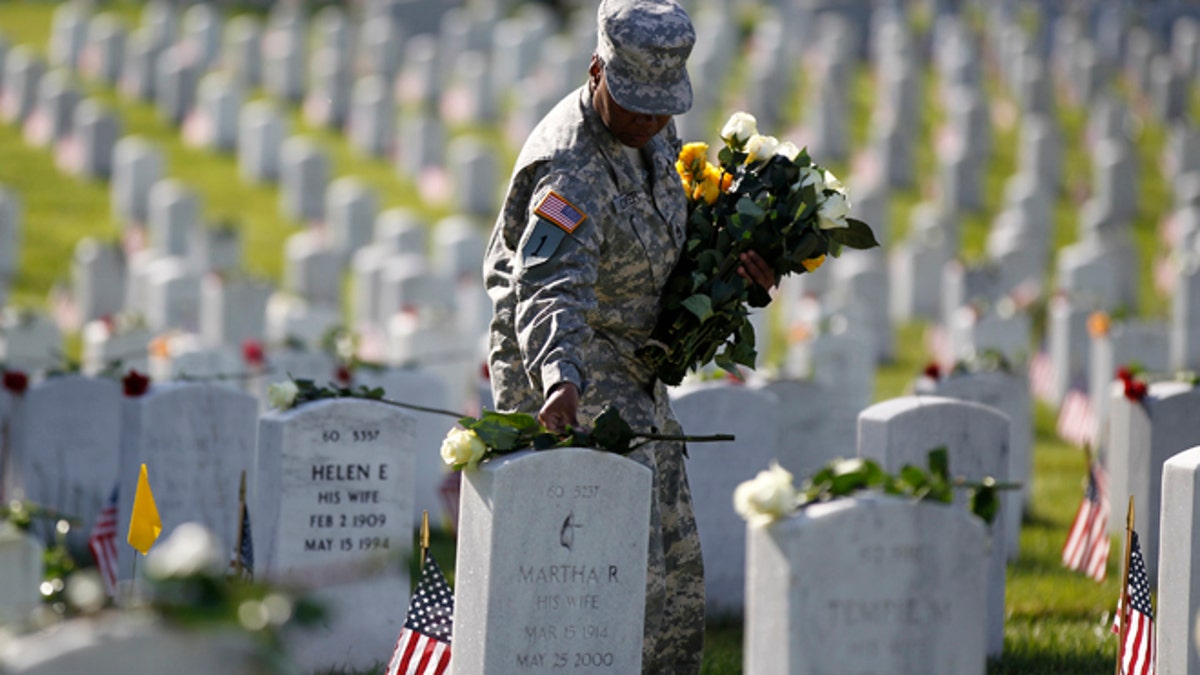
May 27, 2013: A soldier places roses on grave stones in Section 60 of Arlington National Cemetery on Memorial Day in Arlington, Va. Iraq and Afghanistan war veterans are buried in Section 60. (AP)
Living close to Arlington National Cemetery, having family and friends there, I sometimes walk among the stones. I read them. I try to remember the life. I walk slowly, thankful.
It is a walk through history.The stones have something to tell me. I am never sure what. Sometimes, I have questions. They never reach my lips, but they are there.
Mostly the sacrifice around me makes me quiet. It seems to impose a serious responsibility for the future. It benefits anyone to take the walk.
Remembered dates always have meanings, birthdays, anniversaries, Easter, Christmas, Fourth of July, D-Day, Pearl Harbor, 9-11. Dates take on a different meaning inside Arlington. They reflect a lifetime.
The cemetery is filled with beginnings and endings, Alphas and Omegas, selfless Americans who gave us an enormous gift between those dates on their stone. Most are not famous, except to those who love them – for whom there is often no one more special.
Sometimes there are flowers. Some stones are large, some small. Some carry words. One picks up the 1932 poem by Mary Elizabeth Frye, a poem entitled “Do not stand at my grave and weep.” The stone reads simply: “I am a thousand winds that blow, I am the diamond glints on snow.”
World War II dates are well represented, along with World War I, the Civil War, Spanish American War, Vietnam, Korea, Gulf War, Afghanistan and Iraq. Some wives and children are buried here. I pass a marker labeled “infant,” child of a fallen veteran. The markers are overwhelming.
Americans, of course, are buried across the world, Normandy to American Cemeteries in 16 countries, all places we have defended freedom. Like this one, they are quiet, but prompt questions.
Another stone at Arlington has a book laid upon it. The book is weathering. It will be gone soon, pursuant to the Cemetery’s rules of decorum. But I cannot just walk by.
The stone with the book is not far from my great, great grandfather, Ezra Westcote Clark. He fought in the Civil War, is buried with his wife and son, Ezra Westcote Clark Jr., who fought in World War I. The stone with the book is close to my grandmother’s brother, Robert Duncan Clark, who fought in the European Theater during WWII, with his brother.
The book is open. Seeing a book on an Arlington grave is unusual. The book is entitled, “The Jersey Brothers.” I turn the pages. It commemorates three brothers, Navy heroes, World War II, one named Bill. Bill was apparently a Navy Intelligence officer, close to Franklin Delano Roosevelt.
A curling flyleaf speaks of “brotherly love.” I look at the headstone. It is Bill’s. Gently, I replace the book on Bill’s stone. A family member wrote this book. Obviously, it has been given to Bill. I will later get it myself, but this one is Bill’s.
I move to other sites. Questions are always the same. How short was that life? What did he or she see? Who did they leave behind? What did he miss? What drew him to serve? Could he have imagined … Yes, probably. What do we owe? Too much, a lot.
I get to another relative’s marker. As if the date of this family member’s passing was yesterday, I recall them vividly. Only it was years. I visit the marker commemorating six Navy Intelligence friends. They left on 9-11. What can we now do? How can we be equal to their sacrifice? That is the real question.
I think about that question, as I walk. Summer heat and humidity pile up between stones. These Americans, to a one, would expect us – America’s living generations – to understand they gave, served and ended here, for high cause, with a passion for what was bigger than themselves. They are here, because they put America first.
Finally, I stand beside two stones. They are not famous. They both served with honor, one on USS Kittiwake, the other the USS Colorado. Their service was on the periphery, not like Bill and the Jersey Brothers. One was enlisted, the other Academy. Both gave all they could to America, counted themselves lucky to be Americans.
I ask the question that has gnawed. I feel I can ask them. It is the question of the day: Can you see where we are? Can you see the struggles our nation is facing? How do we recommit ourselves to being “One Nation, under God, indivisible” working faithfully for “liberty and justice” in our time? It sounds lofty, but is practical. It needs an answer.
My grandfather and father, vocal in life, are quiet. The other stones are, too. Gates will soon close. I am alone with them. There does seem to be a consensus. These stones expect something of us, of anyone who passes through, and any who know of this place. They expect us to understand what was passed forward.
In their silence, they speak. In the volume of headstones, dates, and reminders, they impose a burden. What they are saying is that the obligation rests squarely on us, to remember what it means to be American, to redouble work for consensus, preserve what they lived and died for, be equal to our time. They were.
There is something powerful and ineffable, deeply humbling, about a walk through Arlington. Inspiration and expectation spread as far as an eye can see. On the Fourth of July, we have marching orders. The stones give them to us. We must do a better job of listening, honoring, respecting and acting as “One Nation,” because it is upon that understanding that all else rests. Grateful for another walk. Tough talk, as always – but good.




















